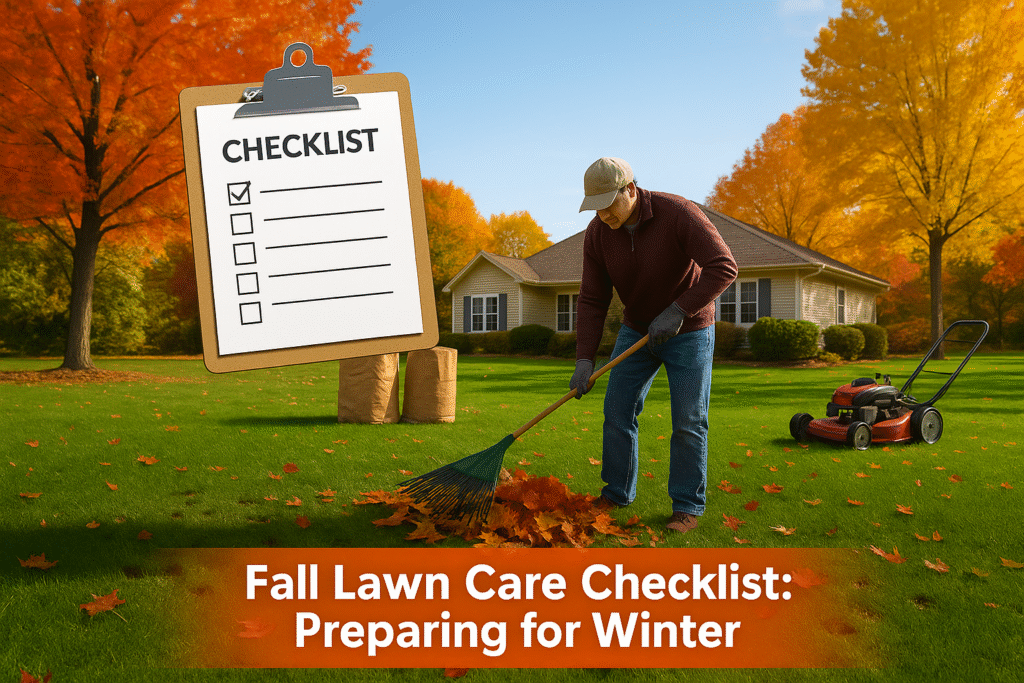You know that feeling when your neighbor’s lawn looks amazing in spring? While yours is still patchy and brown? The secret isn’t luck or expensive treatments. It’s what they did last fall.
Fall lawn care makes the difference between a gorgeous yard and a mediocre one. Your grass doesn’t magically fix itself over winter. It needs your help now to survive the cold months ahead. Cool nights and warm soil create perfect conditions for strengthening grass. Think of September through November as your lawn’s training camp. Every task you complete now pays off when spring arrives.
September: Setting the Foundation
Those Falling Leaves Need to Go
Maple and oak leaves look beautiful on trees. On your lawn? They are trouble waiting to happen. A thick mat of leaves creates the perfect environment for snow mold, which can seriously damage your grass over winter. Walk around your yard weekly. Grab that rake and clear them out.
Here’s a simple test: Can you see individual grass blades through the leaves? If the answer is no, you have waited too long. Don’t try to clear everything at once. Weekly cleanup prevents the overwhelming pile-up that happens in late October.
Your Lawn is Hungry After Summer
Summer heat stresses grass roots. September is recovery time. The combination of warm days and cool nights makes fall ideal for grass establishment and feeding existing lawns. Choose slow-release nitrogen fertilizers for steady nutrition. Skip those “weed and feed” combo products if you are planning to plant new seed. They will kill your new grass along with the weeds.
Your timing matters here. Mid-September works well in most regions. The goal isn’t making grass grow taller – it’s building stronger roots that can handle winter freezing.
Give Your Soil Room to Breathe
Summer foot traffic packs soil tight. Grass roots struggle in compacted earth. Fall aeration solves this problem naturally.
You can rent core aerators from most hardware stores. These machines pull small plugs of soil, creating space for roots to expand. The holes also help water and fertilizer reach deeper into the ground.
Wait for the right soil conditions. You want it moist but not muddy. Most people schedule aeration after a light rain when soil gives under pressure but doesn’t stick to your shoes.
October: Keep the Momentum Going
Planting New Grass
October gives you the last good window for overseeding in northern areas. Fall lawn care is straightforward when you follow proper steps, and timing seed planting correctly is crucial.
Post-aeration seeding works beautifully. Seeds drop into those aeration holes where they make direct soil contact. No need for straw or other coverings.
Keep newly seeded areas consistently moist. Light, frequent watering beats heavy, occasional soaking. Morning watering prevents fungal problems that develop in evening moisture.
Adjust Your Mowing Strategy
Your cutting approach changes in October. Gradually lower that mower height as grass growth slows down. In late fall, cut grass 1-2 inches shorter than normal for your final mowing.
This isn’t random advice. Shorter grass prevents leaves from matting down and blocking sunlight. But don’t scalp your lawn too early – grass needs adequate length to photosynthesize during warm October days.
Save the shortest cut for your very last mowing session of the season.
Stop Weeds Before They Start
Dandelions and other weeds use fall to prepare for next year’s invasion. Pre-emergent herbicides applied now prevent spring weed headaches.
Apply treatments before your area’s first frost date. Prevention always costs less than trying to kill established weeds later.
Remember: Never apply herbicides near newly planted grass seed. Young seedlings die just as easily as weeds from chemical treatments.
November: Final Push Before Winter
Last Call for Cleanup
November cleanup determines how your lawn looks next spring. Don’t let leaves pile up – thick mats create perfect conditions for snow mold that damages grass under winter snow.
Walk your entire property one more time. Remove all leaves, sticks, and debris from grass areas. Pay extra attention to corners where wind deposits extra material.
One heavy snow on uncleared leaves can kill the grass underneath. The cleanup effort now saves you from replanting patches next spring.
Show Your Mower Some Love
Your mower worked hard all season. Clean grass clippings from the deck and underneath. Change the oil while the engine is slightly warm – it drains better.
Sharp blades make clean cuts that heal quickly. Dull blades tear grass, leaving brown tips that invite disease problems. Get blades sharpened during the storage season.
Add fuel stabilizer to prevent carburetor problems. This small step saves expensive repair bills when you try to start up next spring.
Winter Fertilizer Makes the Difference
Apply slow-release fertilizer in mid-to-late fall to promote root growth that helps grass survive winter dormancy and recover faster in spring. Winter fertilizers contain less nitrogen and more potassium. This balance strengthens grass for cold weather. Apply before ground freezes solid in your area.
Avoid over-fertilizing – excess nitrogen creates tender growth that winter kills anyway.
Know Your Grass Type
Cool-Season Varieties
Kentucky bluegrass, fescue, and ryegrass love fall weather. These types grow actively until the first hard frost hits. September and October provide their best planting window.
These varieties handle snow cover and spring freeze-thaw cycles naturally. Fall feeding and overseeding work perfectly for these grass types.
Warm-Season Grass Differences
Bermuda and Zoysia grass prepare for dormancy earlier. Reduce watering frequency as growth slows down. Stop fertilizing these varieties earlier than cool-season types.
Late feeding encourages tender growth that freezes easily. Let these grasses harden off naturally for winter.
Don’t Make These Mistakes
Fertilizer Problems
Never use “weed and feed” during overseeding. The herbicide kills new grass seeds along with weeds. This mistake wastes money and delays lawn improvement.
Over-fertilization causes more harm than under-feeding. Follow label rates exactly. Too much creates soft growth that winter damage destroys.
Timing matters tremendously. Too early wastes money on summer heat stress. Too late applies nutrients to frozen ground.
Mowing Height Errors
Don’t cut grass too short too early. Maintain normal height through September and early October. Grass should be maintained at proper height throughout the growing season.
Long grass under snow creates disease problems too. Final cut should leave grass around 2-3 inches tall – short enough to prevent snow mold but long enough to photosynthesize.
Leaf Management Issues
Ignoring fallen leaves until spring creates serious damage. Trapped moisture under leaf mats breeds fungal diseases that kill grass.
Don’t obsess over every single leaf either. A thin scattering provides natural fertilizer as it decomposes. The key is preventing thick mats that block light and air circulation.
What You will See Next Spring
Stronger Root Systems
Fall care work happens underground first. Stronger roots develop during cool weather when grass energy goes downward instead of into blade growth.
These roots survive freezing and thawing better than shallow ones. Lawns that skip fall feeding stay brown longer and recover slower in spring.
Disease Prevention Benefits
Healthy grass fights diseases naturally. Proper fall mowing helps prevent snow mold by improving air circulation around grass plants.
Good fall care reduces the need for fungicides next year. Prevention always costs less than treatment after problems develop.
Earlier Green-Up
Well-prepared lawns green up weeks earlier than neglected ones. Your grass starts growing while others remain brown and dormant.
This early start compounds throughout the growing season. Healthy spring grass competes better against weeds and handles summer stress more effectively.
Your Action Timeline
September: Schedule aeration, apply first fertilizer, start weekly leaf removal, begin overseeding projects.
October: Continue overseeding care, apply weed treatments, gradually reduce mowing height, monitor new grass growth.
November: Complete final cleanup, service equipment, apply winter fertilizer, make your last mowing pass.
The Bottom Line
Fall lawn care isn’t rocket science, but timing makes all the difference. Start early in September and work systematically through November. Climate affects your timing. Northern regions start earlier than southern areas. Watch local weather patterns and first frost dates for best results.
The work you do these next few months determines how your lawn looks next spring. While your neighbors wonder why their grass looks terrible, you’ll know the secret: fall preparation creates spring success.






